Ron Sabey (Dumfries), Chris Edge (Borders) David Hambley and Jim Arnott (Dunfermline) traveled down to RAF Barkston Heath in Linconshire for the British Free Flight (FF) Nationals over the Whitsun Bank Holiday weekend. This 3 day event organised by the British Model Flyers association (BMFA) is the largest of its kind in Europe and attracts competitors from UK, Ireland and mainland Europe. When we arrived on Friday afternoon and made camp there was a stiff wind blowing which barred any thoughts of a last minute trimming session. We settled for a brisk walk around the fishing lakes at the Woodland Waters camp site and a meal in Woody’s restaurant, with portions which would have defeated Desperate Dan.
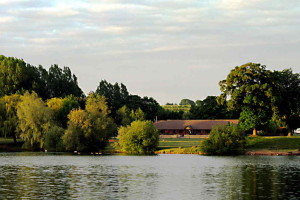 Woody’s Restaurant at Woodlands Water Camp Site – photo D.T. Hambley
Woody’s Restaurant at Woodlands Water Camp Site – photo D.T. Hambley
Saturday morning there was a breeze of about 12 mph from the east and control was based near the Flying School at the east side of the airfield. David flew in the E36 class. After a few test flights with his new model (Super Pearlite) he decided that this would require more time to fully trim and so reverted to his well proven Super Pearl for the contest flights. The decision was rewarded with a very nice comfortable max on its first flight. The second flight a bad launch saw the model loop and come in heavily after 15 sec. Fortunately there was no damage apart from a broken prop and the sub 20 sec time allowed a second attempt at the flight. This time David launched it perfectly and the Super Pearl scored another comfortable max. For the third flight, with the motor run reduced to 10 secs, the Super Pearl again climbed nicely and returned the max required to qualify for the fly-off.
Ron flew in BMFA glider with his Junior A/2. On his first flight he found a good patch of supportive air and the model was well on its way to a max, but a miss set D/T brought the flight to disappointing early end. Ron spent the rest of the day trimming his two vintage gliders, the Nord and the Odenman.
Jim flew in BMFA Rubber using an Urchin with a modern prop. On his first flight, it was clear soon after launch that he had chosen the air badly as the model was struggling to climb. When the prop folded it looked high enough to get the max, but the Urchin then started to stall and it landed 5 secs short of the required time. Jim’s second flight took the small step from the ridiculous to the sublime. Launched into a big thermal, it d/t’d very high up at 2:30 and took another five minutes to come down by which time it had drifted about 1 ½ miles and was way off the airfield. By the time Jim fetched that one back he was physically wrecked and retired for the day.
In the afternoon David turned his attention to BMFA Glider, flying his straight tow Old Peculiar. With the drift now coming from the South East, David towed along the perimeter track towards the small hanger until he felt an encouraging tug on the line. The Old peculiar settled into a buoyant patch of air and held towline height until the max was achieved. Two very similar flights in well chosen air followed to give David the three maxes he needed. It was a very good day indeed for David in qualifying for two fly- offs.
For the fly off’s control moved to the South East corner of the airfield and the 10 mph breeze was towards the beacon outhouse. The temperature was distinctly cool and there was little lift around when the E36 fly off started. David was one of five fliers in the fly-off. His motor run of 3.5 secs was well short of the 5 secs allowed and despite a good pattern climb his model was always below the others and was down in 54 secs in fifth place.
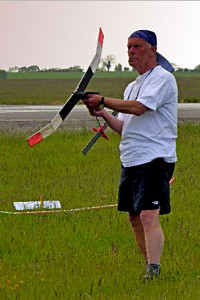 David studies the air during the E36 Fly-off. – photo D Hipperson
David studies the air during the E36 Fly-off. – photo D Hipperson
There were 17 fliers qualified for the BMFA Glider flyoff, which started at 7:50pm. Some late evening sunshine was a mixed blessing with slightly warmer air but the models were drifting straight into the setting sun which made timekeeping difficult. David’s tow and launch were good and the Old Peculiar held up well in some gently supportive air for a good flight of 3:41. As the times came back to control it was clear that others had found better patches of air and David finished in joint 8th place. The event was won by Richard Jack with a flight of 5:34
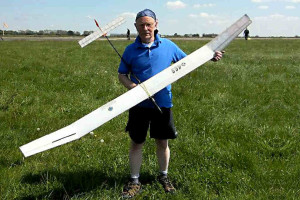 David in the BMFA Glider Fly-off with his Old Peculiar -photo J Arnott
David in the BMFA Glider Fly-off with his Old Peculiar -photo J Arnott
Sunday morning started with a breeze of some 12 mph from the West-southwest. It was overcast and threatening to rain. Our expeditionary team all flew in F1a Glider. The max for the first two rounds was set at 2:00 and these flights had to be completed by 12 noon. There would be three scheduled rounds in the afternoon. David, Ron and Jim all started well with a max on their first flight. In the second round, Jim got his max but Ron and Davids’ were in really poor air and down in 1:04 and 1:28 respectively.
For round 3 and round 4, the max was increased to 2:30. The wind had now freshened to 15 mph. David and Jim found good patches of lift for comfortable maxes in Round 3, but Ron retired from the event after dropping more time. Jim was lucky then unlucky on this flight. As his Superba d/t down in-line with the small hanger it was unclear, from a mile away, if it was on the hanger roof or over. When he reached it, he was delighted to see it lying on the grass 20 ft behind the hanger. Then he discovered that it had hit a solitary telegraph pole, broken the tailplane, and ripped the wing covering. Some quick field repairs with carbon tow and superglue, then Magictape to cover the holes soon had it ready for round 4.
In round 4, David had another comfortable max while Jim had more dramatics. At the moment of launch his model would not release from the line so he pulled it back in as gently as he could for a second attempt. This attempt was good and the model went away for a comfortable max finishing tight in the southeast corner of the drome. With the more testing wind conditions and longer maxes many entrants had dropped time over rounds 3 and 4 and there were now only four fliers with full scores – Phil Ball, Brian Baines, John Williams, and Jim.
The breeze freshened more for round 5, to say 18 mph. It was like a fly-off atmosphere with those four fliers watching each other. Jim was first away with a good launch into what felt like nice air. Phil followed immediately with a straight tow and high bunting release. After looking good for two circles, Jim’s Superba lost the good air and started dropping. A couple of circles later it was climbing again and finished high up and well off the drome, to give him a place in the fly-off. John William’s max was never in doubt after a super launch, however Brian Baines needed a slice of luck after a mistimed launch saw his model bunt down to 50 ft before picking up by good air for his max. So the same four flyers continued into the fly-off with full scores.
David finished his event with another nice max which d/t’d down off the airfield, which moved him further up the rankings to finish in 6th place alongside Stu Darmon, and 4 secs behind John Cooper in 5th place. Then David and Jim discovered that the max for round five had been reduced from 2:30 to 2:00. No harm done but, if had we known, it might have kept us on the airfield and made model retrieval much easier.
As the crowds gather around control at 6pm to see what the fly-off schedule would be, it was noted that the members of the Free Flight Technical Committee were huddled together in deep debate. When they broke up they announced that there would be no fly off’s and flying was finished for the day due to technical reasons. The score at the end of round five were therefore the final result and the four F1a leaders was declared 1st equal. There was a similar position in F1b, F1c, and Vintage Power/Rubber.
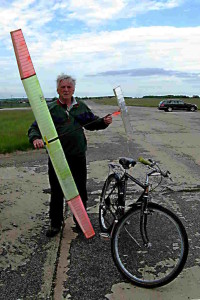 Tired but happy after 5th max -Jim 1st equal in F1a, the third time in 4 years! -photo D.T. Hambley
Tired but happy after 5th max -Jim 1st equal in F1a, the third time in 4 years! -photo D.T. Hambley
On Monday morning there was an announcement that, since the wind was blowing in the same direction, all events would be run to a 1:30 max to keep models on the airfield as far as possible. The wind was quite a bit lighter at 10 mph and anything under 4 minutes would stay on the field. These benign conditions remained all day and it became a case of trying to avoid that pervasive moment of senility which catches you by surprise.
David flew in Classic Glider with his Sans Egal and it was flying nicely on its way to achieving the three maxes. Ron flew in Classic Glider with his Seraph and Vintage Glider with his new model, the Odenman A/2. He achieved the necessary flight times with both to book his place in two fly-offs. He was particularly pleased with the performance of the Odenman which did comfortable max flights even though Ron was launching off a 75M line rather than the 100M allowed. Jim flew in Mini-vintage with his Gollywock and Classic Rubber with his Urchin. Both completed their max flights to get into the fly offs.
By 5pm, along with most of the other contestants we had completed our full house in all five events. There had been moments of doubt with at least three “early” d/t’s but in all cases the flights had been high enough to max anyway. The Free Flight Tech Committee announced we were now clear to have normal unlimited fly offs. With over sixty fliers qualified for the various fly-offs and the wind now freshening to 15 mph, the surrounding fields were about to be bombarded with models.
In the mini-vintage fly off, Jim’s Gollywock was up and down in mediocre air in a disappointing 2:14 to finish in 11th place.
In Classic Glider, David launched his Sans Egal into what looked like good air, but surprisingly it developed a stall which prevented it going away and it was down in 2:49 for 6th place. In the same event when Ron towed up his Seraph, the wings were bending as it strained to get away in a boomer, but on release it failed to drop the towline. Without the auto rudder it flew a massive left hand circle taking it out of the lift. The line caught on the ground low down and allowed the Seraph to fly free from 50 ft up so was timed for a 44sec flight.
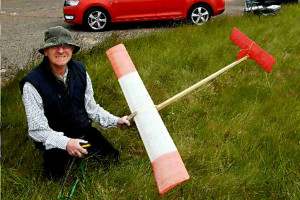 Ron prepares his Seraph for the Classic Glider Fly-off -photo J Arnott
Ron prepares his Seraph for the Classic Glider Fly-off -photo J Arnott
Ron then turned his attention to Vintage Glider with the Odenman. He towed it on a 100M line for the first time. It was a weaving quite a bit but Ron managed to release it nicely into its turn around 80M height. The model was gliding very well but it did not find true lifting air and it eased its way down for a time of 3:13,landing just inside the perimeter fence. This gave Ron 4th position.
Our final event was the Classic Rubber/Power, where Jim was flying an Urchin. It was a similar tale for Jim, with a good steady flight but missing the best of the lift for a time of 3:50. The model was well off the field and was eventually tracked into a farm courtyard.
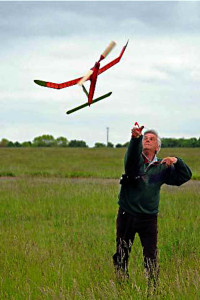 Jim gets his Urchin away in the Classic Rubber Fly-off -photo D Hipperson.
Jim gets his Urchin away in the Classic Rubber Fly-off -photo D Hipperson.
Chris Edge had a very good day in F1h having quietly flown away from the madding crowd and qualified for a four way fly-off. After a 10minute circular tow he won handsomely with a 5:09 flight while the other contenders were under 2 minutes.
Unusually we had enjoyed good flyable conditions on all three days and it was great to have it dry all weekend. Having two fly-off spots on Saturday, one on Sunday, and five on Monday showed that we are still contenders at this level, and had Lady Luck smiled a little more kindly we could have had bonanza of trophies. It had been a very successfull three days.
Report by Jim Arnott.
